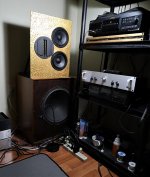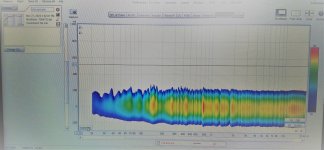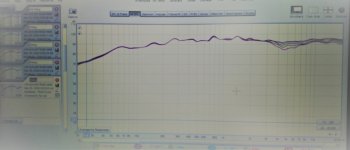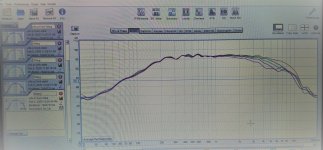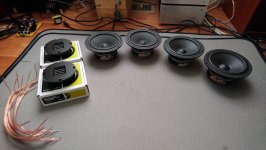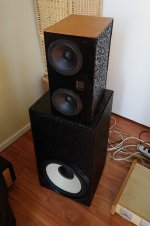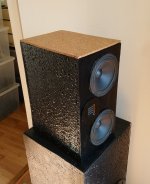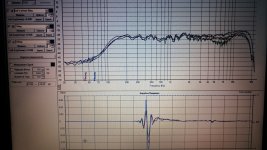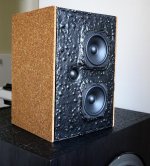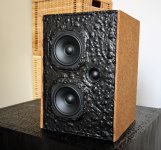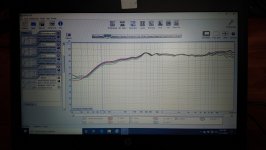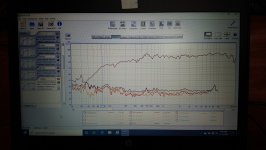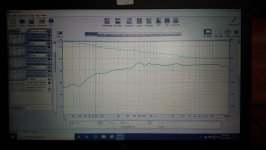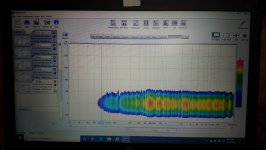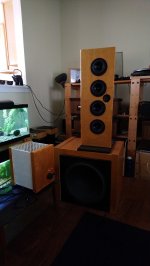With respect for Joes comments, I would not feel bound by broader observations when designing a specific speaker, especially where I am taking careful control of said differences and properties.I favor in-phase, i.e., even-order, crossovers for most applications because
they are the least sensitive to inter-driver phase differences and timing errors. In the case of the MTM configuration they also limit off-axis response in the vertical which greatly reduces floor and ceiling reflections.
An MTM that does not pursue wide dispersion is fine, more and more directivity is a consideration. It could be done, for e.g..
#System7 Steve, have you ever seen vertical polars for a ribbon MTM that you could show?
I had a friend that thought a mtm sounds like listening to sound through a pipe.
Unnatural.
No argument on less distortion.
The lobe, or cancellation, maybe we hear that in the floor (maybe) and / or ceiling bounce.
I couldn't tell you if it is the crossover lobe or the driver combing lobe that is the cause for the "focused" or "pipe" sound.. i think it is the woofer combing we hear.
Dunlavy sc1, mtm with 2 x 5.5" drivers.
It seemed to cross at 3-3.5khz.
Recommended listening at 10' distance.
See measurement 5 for vertical dispersion.
You see a huge dip forming 45 degrees off axis at 700hz.
I'm sure the frequency of the dip moves higher and higher as you angle closer to directly on axis (from 45 degrees) to the mtm.
Dunlavy Audio Labs SC-I loudspeaker Measurements | Stereophile.com
He did say (my buddy), the lower crossed the better.
His mtm didn't measure better as he moved the crossover point down, but it did sound better.
I think he did 6.5" mtm crossing acoustically (driver roll off plus electrical) at 24db.
To me, an mtm should act as a point source.
You should cross near dispersion limitation vertically at the 2 driver and tweeter total height
So, assuming our tweeter is infinitely small, a mtm using 4" drivers seem to act (vertically) as an 8" woofer.
And, I'd i like to see an 8" cross at 2khz...
So, a 2 x 6.5" with 2" framed tweet, ideally should cross as a 15" driver, or 800hz.
But, good luck with a 2" framed tweet crossing that low.
But a 2" full range, maybe.
Narrowing dispersion of an mtm ?
Not in the tweeter range.
Unnatural.
No argument on less distortion.
The lobe, or cancellation, maybe we hear that in the floor (maybe) and / or ceiling bounce.
I couldn't tell you if it is the crossover lobe or the driver combing lobe that is the cause for the "focused" or "pipe" sound.. i think it is the woofer combing we hear.
Dunlavy sc1, mtm with 2 x 5.5" drivers.
It seemed to cross at 3-3.5khz.
Recommended listening at 10' distance.
See measurement 5 for vertical dispersion.
You see a huge dip forming 45 degrees off axis at 700hz.
I'm sure the frequency of the dip moves higher and higher as you angle closer to directly on axis (from 45 degrees) to the mtm.
Dunlavy Audio Labs SC-I loudspeaker Measurements | Stereophile.com
He did say (my buddy), the lower crossed the better.
His mtm didn't measure better as he moved the crossover point down, but it did sound better.
I think he did 6.5" mtm crossing acoustically (driver roll off plus electrical) at 24db.
To me, an mtm should act as a point source.
You should cross near dispersion limitation vertically at the 2 driver and tweeter total height
So, assuming our tweeter is infinitely small, a mtm using 4" drivers seem to act (vertically) as an 8" woofer.
And, I'd i like to see an 8" cross at 2khz...
So, a 2 x 6.5" with 2" framed tweet, ideally should cross as a 15" driver, or 800hz.
But, good luck with a 2" framed tweet crossing that low.
But a 2" full range, maybe.
Narrowing dispersion of an mtm ?
Not in the tweeter range.
Last edited:
More output, less distortion, always helps.
Some think mtm can use 1 woofer as a baffle step driver, but that's not really a mtm.
Here is another article.
20 and 30 degrees vertical off axis causes a big dip 800-2.5khz
It uses 2 x 5" with a crossover point of 2.7khz at 12db.
Making of The Dayton Reference 2-way MTM Center Channel Speaker | blog for whoever
Some think mtm can use 1 woofer as a baffle step driver, but that's not really a mtm.
Here is another article.
20 and 30 degrees vertical off axis causes a big dip 800-2.5khz
It uses 2 x 5" with a crossover point of 2.7khz at 12db.
Making of The Dayton Reference 2-way MTM Center Channel Speaker | blog for whoever
Around the crossover, it is basically the same whether TM or MTM.
The problem with LR is its maximum output on axis. This DI discrepancy is normally considered a preferred compromise.
However, add lobing to this and the DI gets larger again. To understand this consider how an odd order crossover handles DI. Furthermore there is now a spectral discrepancy affecting early reflections.
LR and Butterworth are nominal boundaries. I propose that each situation calls for a custom variant.
The problem with LR is its maximum output on axis. This DI discrepancy is normally considered a preferred compromise.
However, add lobing to this and the DI gets larger again. To understand this consider how an odd order crossover handles DI. Furthermore there is now a spectral discrepancy affecting early reflections.
LR and Butterworth are nominal boundaries. I propose that each situation calls for a custom variant.
With respect for Joes comments, I would not feel bound by broader observations when designing a specific speaker, especially where I am taking careful control of said differences and properties.
An MTM that does not pursue wide dispersion is fine, more and more directivity is a consideration. It could be done, for e.g..
No argument from me, we're on the same page. 🙂
#System7 Steve, have you ever seen vertical polars for a ribbon MTM that you could show?
I'd be interested it seeing some too; I don't recall many off the top of my head. I can't picture it behaving all that much like a cylindrical wavefront though -not consistently at any rate given the limited length. It's been some time since I looked at arrays, but if memory serves, non-infinite types transition to point source behaviour when you shift into the Fraunhofer field.
When using a waveguide (e.g. 12” wide 90x60 dispersion), which topology would result in the most uniform dispersion between M and T?
(1) MTM with 2 x 12” mids (assuming the 12” WG);
(2) TM with 12” mid;
(3) TMM with 2 x 6” mids, oriented horizontally below the WG; or
(4) MMTMM with 4 x 6” mids, two of them oriented horizontally above the WG and two horizontally below.
(1) MTM with 2 x 12” mids (assuming the 12” WG);
(2) TM with 12” mid;
(3) TMM with 2 x 6” mids, oriented horizontally below the WG; or
(4) MMTMM with 4 x 6” mids, two of them oriented horizontally above the WG and two horizontally below.
Cool Scott,
I'm very interested how a full range driver sounds under pink,....on - vs off -axis.....pls do fill in...
and in my strong opinion........
SINGLE SPEAKER MONO IS THE ONLY WAY TO EVEN HAVE A FAIR CHANCE AT EVALUATING SPEAKERS...
(i said it quietly lol)
My test involved listening to two speakers at various distances and one. When I moved my head only a few inches from side to side there was a change in the intensity of the higher frequencies, it sounded the same in all circumstances. I conclude that it's due to the angle of my ear to the speakers, in other words, the pinna/head related transfer function, and not changes in phase or comb filtering.
Any speaker you care to mention sounds different off-axis. I always thought the 1980's Wharfedale E70 was brilliant!
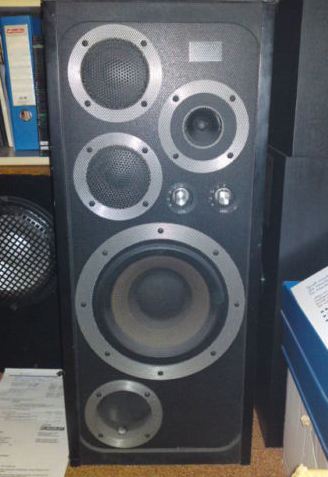
After years of listening to polite but dull BBC speaker 2 ways, along came this efficient and dynamic 3 way 90dB bad boy. 😀
The 300-3000Hz paper cone voice range was done brilliantly well. You could hear every word sung or spoken. No-one wanted to admit it blew everything else away!
And remember, MTM only puts half the mids power into the room for the same SPL. So is strangely quieter and less fatiguing.
Still my dream project in some ways. Cost effective to the max. Series-wired mids as it goes. Remember, 3kHz is 5cms displacement on half-wavelength. We can all do the math. Ought to be good for 10 or 20 degrees above and below axis without disintegrating totally.
After years of listening to polite but dull BBC speaker 2 ways, along came this efficient and dynamic 3 way 90dB bad boy. 😀
The 300-3000Hz paper cone voice range was done brilliantly well. You could hear every word sung or spoken. No-one wanted to admit it blew everything else away!
And remember, MTM only puts half the mids power into the room for the same SPL. So is strangely quieter and less fatiguing.
Still my dream project in some ways. Cost effective to the max. Series-wired mids as it goes. Remember, 3kHz is 5cms displacement on half-wavelength. We can all do the math. Ought to be good for 10 or 20 degrees above and below axis without disintegrating totally.
Last edited:
here is my vifa mtm, with amt tweeters, the most neutral speakers i made so far
Attachments
MTM is a load of rubbish, adason:
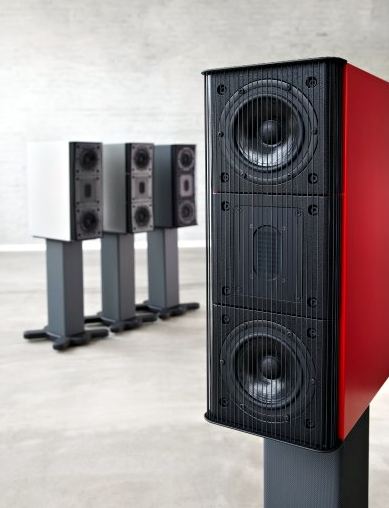
I forbid you from even trying this idea!
Seas CA15RLY X2 cabinet volume suggestions
Let's waste another 50 years on bad ideas. 😎
I forbid you from even trying this idea!
Seas CA15RLY X2 cabinet volume suggestions
Let's waste another 50 years on bad ideas. 😎
Last edited:
Long ago Speaker Builder magazine published D'Appolito's "Swan" design. It used an MTM on top of a large bass box. I remember he wanted you to cut the top and bottom off a Dynaudio tweeter so the M-M distance could be as small as possible. I still have the drivers in a box if I ever get a free moment to build it. Given that the Dynaudio tweets aren't available anymore, I'd be hesitant to cut the plates, even though I have a pretty good metal shop.
MTM is different On-axis! A particular characteristic of MTM
Well, it is until until I hear one that removes the characteristic. If it is inherent, then it will never happen 🙂
Well, it is until until I hear one that removes the characteristic. If it is inherent, then it will never happen 🙂
suit yourself! (you are obviously wrong, you can make any speaker flat on axis)
ok, this is last post with pic, even I have made many other mtm based speakers
i made mtm with dome mids, and even removed front plates to make spacing with tweeter much closer
now this is my best speaker so far, resides in living room, it actually is 2.5 way mmtmm, on dual 15" woofers
ok, this is last post with pic, even I have made many other mtm based speakers
i made mtm with dome mids, and even removed front plates to make spacing with tweeter much closer
now this is my best speaker so far, resides in living room, it actually is 2.5 way mmtmm, on dual 15" woofers
Attachments
Last edited:
- Home
- Loudspeakers
- Multi-Way
- MTM sound characteristics

